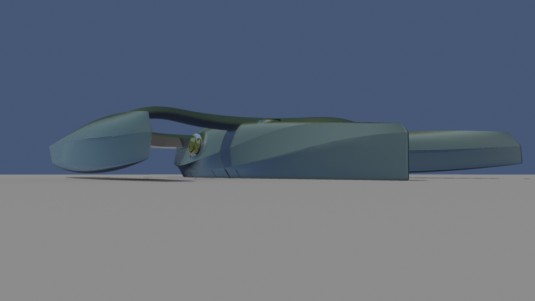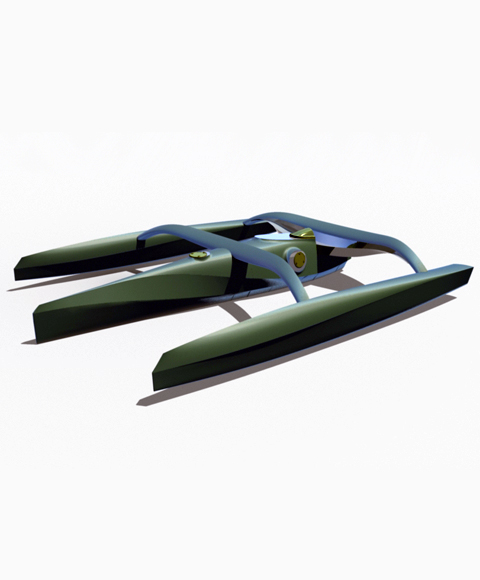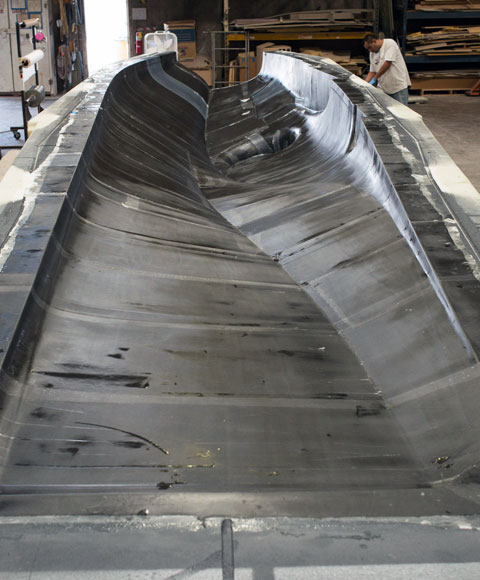Architect Greg Lynn is pioneering a new language of form, taking advantage of real-time ray tracing hardware and software from Imagination Technologies to see light and shadow at the earliest design stages.
The recent America’s Cup yacht racing championship in San Francisco (see “More than a boat race”) brought attention to how the application of technology has revolutionized the design and engineering of the top-end racers. By using structural and fluid dynamic engineering tools, 3D CAD, and sophisticated materials, teams like BMW Oracle and Emirates New Zealand set records and captured the world’s attention.

Below the level of America’s Cup competition, yacht design remains a “do what you see” process. Boat-builders call it “agricultural” which is their slang for “non-designed;” boats are built for performance, and performance is based on seeing how the last one did. The technology is in place, but what is lacking, says architect Greg Lynn, is a design language to match the new high-tech processes of engineering and construction.
Lynn has an A List of clients (Google, Swarovski, BMW, Guggenheim, HSBC) and has been honored for his influence by Forbes Magazine and Time. In recent years he has turned his attention to yacht design, and sees a need to continue the revolution started by the America’s Cup. “[While yacht design is] very sophisticated in terms of analysis and construction, it’s very backwards in terms of design,” says Lynn. “Although the materials are close to the level of sophistication of the aerospace industry, the way things are designed is very much the way they were done in the days of wood planks.”
Lynn, who also is a member of the architecture faculty at Yale University, proposes a new design language more in keeping with the high-tech processes used to build racing yachts. Now under construction in Maine is the GF 42, a trimaran that incorporates Lynn’s ideas. Working in partnership with yacht designer Frederick Courouble, structural engineer Hervé Devaux, and computational fluid dynamics experts Benjamin Herry & CFD Max, Lynn says his goal has been to create a design language that puts real-time visualization front and center.
“Everyone from the sailing industry who’s seen the GF 42 has been shocked at just at how different it is,” says Lynn. The racing and cruising trimaran is 42’ x 32’, long and sleek with hardly a single straight line below the mast. Lynn works in 3D from the very start of a project, beginning by sketching out forms in Maya. Complete details are worked through in Rhino and MicroStation. But the key difference has been how Lynn works with light and volume.
In order not to become distracted by detail too early, Lynn works primarily in wireframe display mode, with shading to get a sense of volume and closure. He also takes advantage of the new Imagination Technologies Series2 R2100 ray-tracing acceleration card and its Caustic Visualizer viewport plugin for Maya, to display accurate lighting and shadows in real time.

Changing the way designers communicate
“If you’re going to ask someone to do something in a different way to the one they’re used to, you have to show them how to do it,” he says. “Part of that is building mock-ups, but another part, which can be a lot quicker and less expensive, is to show them photorealistic images.” In order to communicate design intent to boat builders Westerly Marine, Lynn relied on photo-realistic renderings the way most designers rely on drawings.
“[In the past], I were to show someone a design, I’d go to two folders [on my hard drive] and say, ‘Here are the images we did six months ago, and here are the images we did three months ago,’.” Lynn says. “Now there are weekly changes and a weekly set of photorealistic renderings to go with them. It’s a continual process, not milestones.”
“For me, rendering is more of an issue in the design process than a presentation tool,” he says. “It’s not so much about being able to render materials photo-realistically: it’s about getting a quality of space and light.”
“I can’t tell you what a difference it makes when you’re looking at something complex to be able to throw shadows on it right away and move the light around,” Lynn says. “It means you don’t need to build a physical model if you don’t need to. And we’re constantly building physical models. We’re overrun with the things.”
Using Caustic Visualizer allows Lynn to show accurate reflections in real time, which he says is critical for visualising the role glass will play in his designs. “A lot of people think of glass as being invisible, so they think of a glass wall as a transparent wall,” Lynn says. “When you start to put on reflections, it gives you a better idea of how that transparency is really going to behave. If you look at something that has layers of glass and transparency on a machine without a Caustic card, it looks really hollow on the screen.”
For Lynn, the effect of being able to change the lighting interactively on his designs and see how the reflections respond is subtle, but profound. “It changes your sensibility,” he says. “You start to think in a more spatial way. If you can see glass as both transparent and reflective, it changes the character of the space you’re drawing.”

Photorealistic images are also necessary to document the evolution of the GF 42, which is being recorded for a book, a filmed documentary, and an article in The New York Times. Lynn estimates that the team at his design practice, Greg Lynn FORM, is generating over a hundred new images a month.
The result of pushing photo-realism upfront into design, Lynn hopes, will be a yacht that looks as revolutionary as the techniques through which it is being constructed.
Beyond the GF 42, Lynn aims to introduce other designers and architects to his workflow. He finds it easy to convince visitors to his studio of the power of fast interactive ray-tracing: “Whenever we show anyone the performance, they flip. And you don’t have to show them a whole lot. All you have to do is open a file, and let them navigate.”





